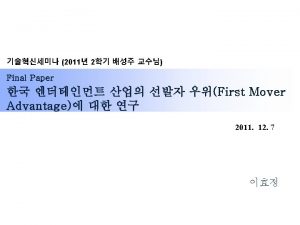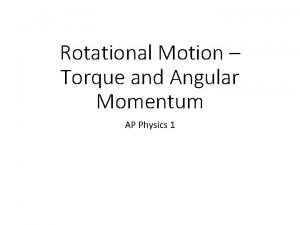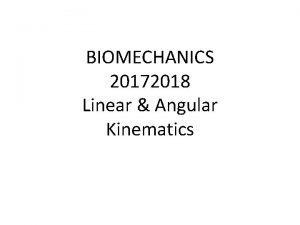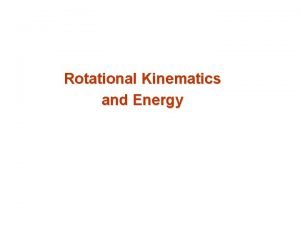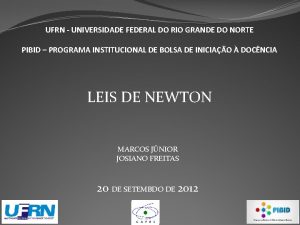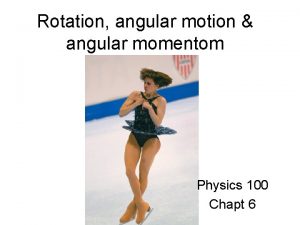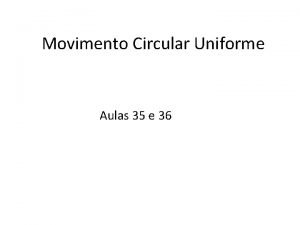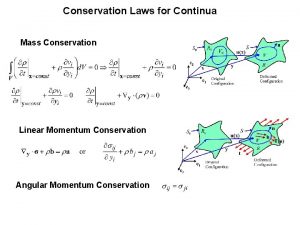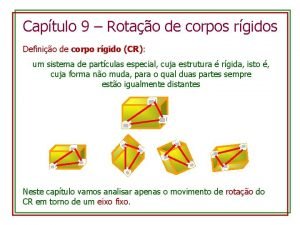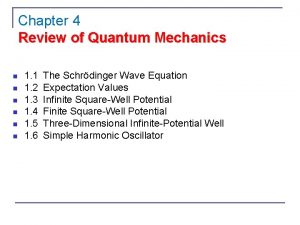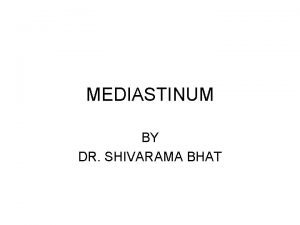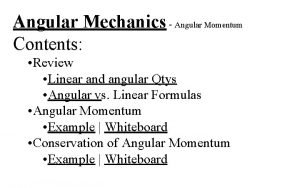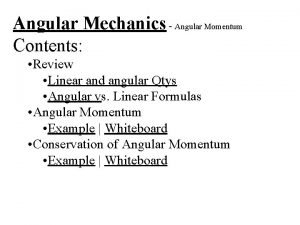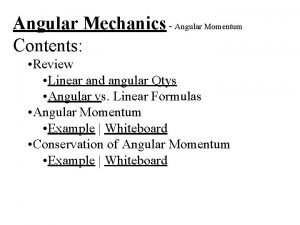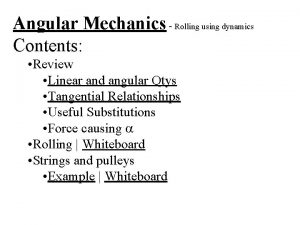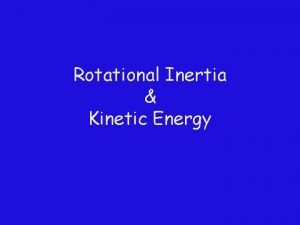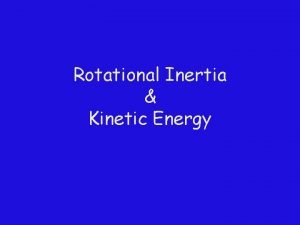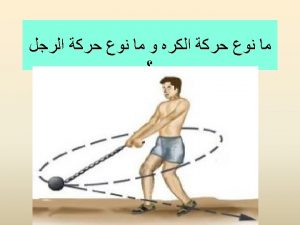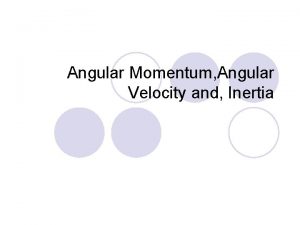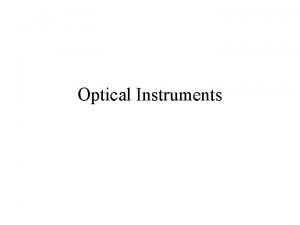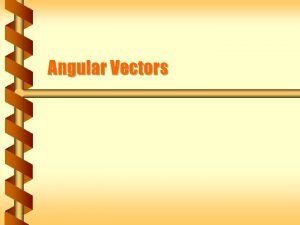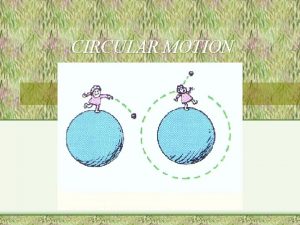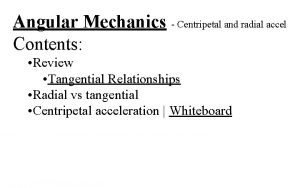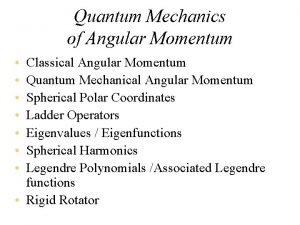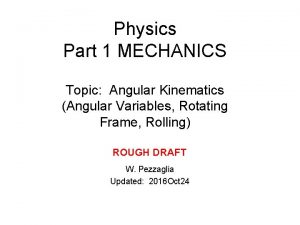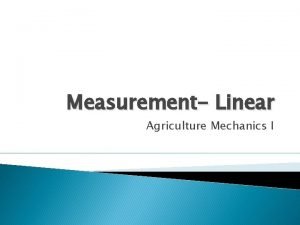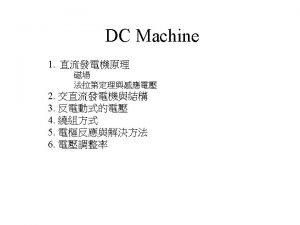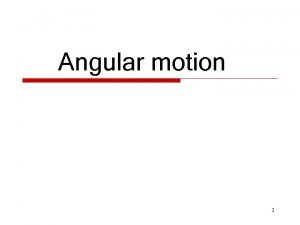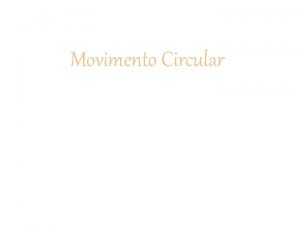Angular Mechanics Contents Review Linear and angular Qtys





























- Slides: 29

Angular Mechanics Contents: • Review • Linear and angular Qtys • Tangential Relationships • Angular Kinematics • Rotational KE • Example | Whiteboard • Rolling Problems • Example | Whiteboard

Angular Mechanics - Angular Quantities Linear: Angular: (m) s - Angle (Radians) (m/s) u o - Initial angular velocity (Rad/s) (m/s) v - Final angular velocity (Rad/s) (m/s/s) a - Angular acceleration (Rad/s/s) (s) t t - Uh, time (s) (N) F - Torque (kg) m I - Moment of inertia

Angular Mechanics - Angular kinematics Linear: u + at = v ut + 1/2 at 2 = s u 2 + 2 as = v 2 (u + v)t/2 = s ma = F 1/ mv 2 = E 2 kin Fs = W Angular: = o + t = ot + 1/2 t 2 2 = o 2 + 2 = ( o + )t/2* = I Ek rot = 1/2 I 2 W = * *Not in data packet

Angular Mechanics - Useful Substitutions = I = r. F so F = /r = I /r s = r, so = s/r v = r, so = v/r a = r, so = a/r

Angular Mechanics - Rotational Ke Two types of kinetic energy: Translational: Ekin = 1/2 mv 2 Rotational: Ek rot = 1/2 I 2 Of course a rolling object has both Demo – ring and cylinder

Example: A 23. 7 kg 45 cm radius cylinder is rolling at 13. 5 m/s at the bottom of a hill. What is its translational kinetic energy? What is its rotational kinetic energy? What is the total kinetic energy? What was the height of the hill?

Angular Mechanics – Rolling with energy I = 1/2 mr 2 h = v/r mgh = 1/2 mv 2 + 1/2 I 2 An 11. 0 g, 0. 0130 m radius cylinder rolls down an incline that is 2. 90 m long, and loses 0. 340 m of elevation. What is its acceleration down the plane, and its velocity at the bottom of the plane? mgh = 1/2 mv 2 + 1/2 I 2 mgh = 1/2 mv 2 + 1/2(1/2 mr 2)(v/r)2 mgh = 1/2 mv 2 + 1/4 mv 2 = 3/4 mv 2 4/ gh = v 2 3 v = (4/3 gh)1/2 0. 767 m/s/s 2. 11 m/s

Whiteboards: Rolling 1

A marble (a solid sphere) has a mass of 23. 5 g, a radius of 1. 20 cm, and rolls 2. 75 m down an incline that loses 0. 650 m of elevation. 1. Solve for v in terms of g and h 2. Plug in and get v 3. suvat for a mgsin = ma + I /r, I = 2/5 mr 2, = a/r mgsin = ma + (2/5 mr 2)(a/r)/r mgsin = ma + 2/5 ma = 7/5 ma gsin = 7/5 a a = 5/7 gsin 3. 02 m/s 1. 66 m/s/s

Whiteboards: Rotational KE 1 -6

What is the rotational kinetic energy of an object with an angular velocity of 12. 0 rad/s, and a moment of inertia of 56. 0 kg m 2? Ek rot = 1/2 I 2 Ek rot = 1/2(56 kgm 2)(12 rad/s)2 Ek rot = 4032 J = 4. 0 x 103 J

What must be the angular velocity of a flywheel that is a 22. 4 kg, 54 cm radius cylinder to store 10, 000. J of energy? Ek rot = 1/2 I 2, I = 1/2 mr 2 Ek rot = 1/2(1/2 mr 2) 2 = 1/4 mr 2 2 2 = 4(Ek rot)/mr 2 =(4(Ek rot)/mr 2)1/2=(4(10000 J)/(22. 4 kg)(. 54 m)2)1/2 = 78. 25 rad/s = 78 rad/s

What is the total kinetic energy of a 2. 5 cm diameter 405 g sphere rolling at 3. 5 m/s? I=2/5 mr 2, = v/r, Ek rot=1/2 I 2 , Ekin=1/2 mv 2 Ek total= 1/2 mv 2 +1/2 I 2 Ek total= 1/2 mv 2 +1/2(2/5 mr 2)(v/r)2 Ek total= 1/2 mv 2 +2/10 mv 2 = 7/10 mv 2 Ek total= 7/10 mv 2 = 7/10(. 405 kg)(3. 5 m/s)2 Ek total= 3. 473 J = 3. 5 J

What work do you do if you exert 14. 0 m. N of torque through 3. 10 rotations? solution 273 J

If you exert 14. 0 m. N of torque through 3. 10 rotations on a potter’s wheel that is a 26. 0 kg, 68. 0 cm diameter uniform cylinder, what will be the final angular velocity? solution 19. 1 rad/s

A tangential friction force of 2. 30 N slows down a 26. 0 kg 68. 0 cm diameter potter’s wheel. (That is a uniform cylinder) If it was originally going at 71. 0 RPM, in how many rotations will it stop? solution 8. 45 rot

In General: I tend to solve all rotational dynamics problems using energy. 1. Set up the energy equation 2. (Make up a height) 3. Substitute linear for angular: • = v/r • I = ? mr 2 4. Solve for v 5. Go back and solve for accelerations

Angular Mechanics – Pulleys and such r Find velocity of impact, and acceleration of system r = 12. 5 cm m 1 = 15. 7 kg m 2 = 0. 543 kg h = 0. 195 m m 1 m 2 h Set up dynamics, do RKE 0. 498 m/s 0. 635 m/s/s

Angular Mechanics – Pulleys and such r m 1 Find acceleration of system r = 46 cm m 1 = 55 kg m 2 = 15 kg m 3 = 12 kg h = 1. 0 m m 2 m 3 h = (made up)



Whiteboards: Rolling with Energy 1|2|3

A 4. 5 kg ball with a radius of 0. 12 m rolls down a 2. 78 m long ramp that loses 0. 345 m of elevation. Set up the energy equation without plugging any of the knowns into it. Make substitutions for I and , but don’t simplify. I = 2/5 mr 2, = v/r mgh = 1/2 mv 2 + 1/2 I 2 mgh = 1/2 mv 2 + 1/2(2/5 mr 2)(v/r)2

Solve this equation for v: mgh = 1/2 mv 2 + 1/2(2/5 mr 2)(v/r)2 mgh = 1/2 mv 2 + 2/10 mr 2 v 2/r 2 mgh = 1/2 mv 2 + 2/10 mv 2 = 7/10 mv 2 10/ gh = v 2 7 v = (10/7 gh)1/2

A 4. 5 kg ball with a radius of 0. 12 m rolls down a 2. 78 m long ramp that loses 0. 345 m of elevation. What is the ball’s velocity at the bottom? (v = (10/7 gh)1/2) v = (10/7(9. 8 m/s/s)(. 345 m))1/2 = 2. 1977 m/s v = 2. 20 m/s

A 4. 5 kg ball with a radius of 0. 12 m rolls down a 2. 78 m long ramp that loses 0. 345 m of elevation. What was the rotational velocity of the ball at the bottom? (v = 2. 1977 m/s) = v/r = (2. 1977 m/s)/(. 12 m) = 18. 3 s-1 = 18 s-1 18 rad/s

A 4. 5 kg ball with a radius of 0. 12 m rolls down a 2. 78 m long ramp that loses 0. 345 m of elevation. What was the linear acceleration of the ball down the ramp? (v = 2. 1977 m/s) v 2 = u 2 + 2 as v 2/(2 s) = a (2. 1977 m/s)2/(2(2. 78 m)) = 0. 869 m/s/s

Angular Mechanics – Pulleys and such r m 1 Find acceleration of system r = 46 cm m 1 = 55 kg m 2 = 15 kg m 3 = 12 kg h = 1. 0 m m 2 m 3 h = (made up)

Angular Mechanics – yo yo ma Find acceleration of system (assume it is a cylinder) r 1 r 2 h = 1. 0 m r 1 = 6. 720 cm r 2 = 0. 210 cm m = 273 g
 Table of contents literature review
Table of contents literature review Ap physics 1 angular momentum
Ap physics 1 angular momentum Angular momentum in classical mechanics
Angular momentum in classical mechanics Angular mechanics
Angular mechanics Angular vs linear velocity
Angular vs linear velocity Linear and angular kinematics
Linear and angular kinematics Angular acceleration and linear acceleration
Angular acceleration and linear acceleration Moment of inertia of a hoop
Moment of inertia of a hoop Velocidade angular formula
Velocidade angular formula Right hand rule momentum
Right hand rule momentum Força centrípeta
Força centrípeta Vmax= aw
Vmax= aw Angular vs linear momentum
Angular vs linear momentum Aceleração angular para linear
Aceleração angular para linear Normalize wave function e^ix
Normalize wave function e^ix Linear regression vs multiple regression
Linear regression vs multiple regression Linear texts
Linear texts Nonlinear narrative definition
Nonlinear narrative definition Difference between linear and nonlinear pipeline processors
Difference between linear and nonlinear pipeline processors Non linear multimedia example
Non linear multimedia example Principle of linear impulse and momentum formula
Principle of linear impulse and momentum formula Persamaan diferensial simultan
Persamaan diferensial simultan Left-linear grammar
Left-linear grammar Difference between linear and non linear equations
Difference between linear and non linear equations Persamaan linear simultan
Persamaan linear simultan Contents of the dead man's pocket
Contents of the dead man's pocket Middle mediastinum
Middle mediastinum Outlining and organizing the speech contents
Outlining and organizing the speech contents Contents of the dead man's pocket questions and answers
Contents of the dead man's pocket questions and answers Chapter review motion part a vocabulary review answer key
Chapter review motion part a vocabulary review answer key
